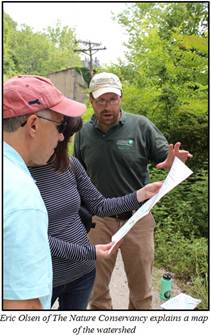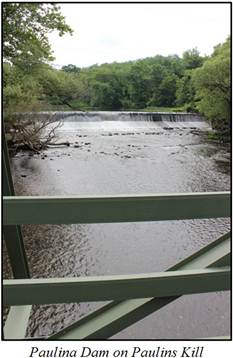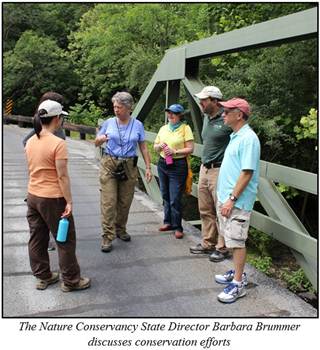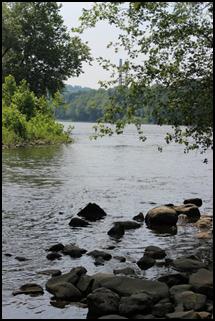How Prosecutions are Fueling Recovery in the Delaware River Basin
 Environmental law enforcement is about more than just punishing polluters: community service payments taken from prosecutions help fund projects that restore and protect some of New Jersey’s most sensitive ecosystems. As the New Jersey U.S Attorney and team saw firsthand last week, the seeds from three such payments are bearing fruit in Northwestern New Jersey.
Environmental law enforcement is about more than just punishing polluters: community service payments taken from prosecutions help fund projects that restore and protect some of New Jersey’s most sensitive ecosystems. As the New Jersey U.S Attorney and team saw firsthand last week, the seeds from three such payments are bearing fruit in Northwestern New Jersey.
U.S. Attorney Paul J. Fishman, along with members of his staff and guides from The Nature Conservancy, journeyed out on July 2, 2014, to Paulins Kill, the third largest New Jersey river draining into the Delaware River. The Nature Conservancy, a charitable organization that works to protect our lands and waters, is working to restore three miles of degraded floodplains to increase healthy habitat and water quality. The Nature Conservancy is also striving to reconnect the Paulins Kill to the Delaware, working with partners to advance removal of two dams in the lower watershed, which, if successful, will restore access of migratory fish like American Shad to their historic spawning grounds for the first time in more than 100 years.

The U.S. Attorney and team spent part of the warm summer day exploring miles of the waterway’s winding bends, bridges, assorted wildlife, and surrounding plains. They were even able to observe some of the work being done to fend off erosion, including new tree sprouts, complete with protective tubes to prevent passing deer from turning them into lunch.
Appropriately, The Nature Conservancy’s efforts were sparked with grant money stemming from pollution cases prosecuted by the U.S. Attorney’s Office for the District of New Jersey. In 2010, The office, together with the U.S. Coast Guard and U.S. Environmental Protection Agency Criminal Investigation Division, won cases against three shipping companies that violated federal vessel pollution laws: U.S. v. Clipper Wonsild Tankers Holding A/S et. al., U.S. v. Dalnave Navigation Inc., and U.S. v. Holy House Shipping AB.

The settlements from the cases included $1,531,391 in community service payments, to be managed by the National Fish & Wildlife Foundation, and designated for use in promoting the health and living resources of the coast and oceans of New Jersey. And a portion of these community service payments, a grant of $321,016 to be exact, went to The Nature Conservancy for work in the Delaware River Basin.
In November 2011, the Delaware River Basin Conservation Initiative, a collaborative of The Nature Conservancy, the Partnership for the Delaware Estuary and Natural Lands Trust, used the grant to complete a scientific study that prioritizes conservation projects that would help ensure a healthy Delaware River and Bay—identifying which sites are most critical, and what conservation actions will have the most impact. It included recommendations for preservation, restoration, and management projects to help keep the Delaware a dependable resource for healthy drinking water (17 million people in New Jersey, New York, Delaware and Pennsylvania drink Delaware River water every day), flood protection, recreation and wildlife habitat.
 The smart conservation blueprint, made possible with that original $321,016 in seed money from the settlement, quickly had a snowball effect. It resonated with other funders, sparking multimillion-dollar support for on-the-ground efforts in the Delaware River Basin from the Robert Wood Johnson 1962 Charitable Trust, the William Penn Foundation and other private donors. So far, the expanded funding has powered The Nature Conservancy’s conservation efforts in New Jersey’s Paulins Kill, as well as in New York’s Neversink River and Pennsylvania’s Bushkill, all major Delaware River tributaries.
The smart conservation blueprint, made possible with that original $321,016 in seed money from the settlement, quickly had a snowball effect. It resonated with other funders, sparking multimillion-dollar support for on-the-ground efforts in the Delaware River Basin from the Robert Wood Johnson 1962 Charitable Trust, the William Penn Foundation and other private donors. So far, the expanded funding has powered The Nature Conservancy’s conservation efforts in New Jersey’s Paulins Kill, as well as in New York’s Neversink River and Pennsylvania’s Bushkill, all major Delaware River tributaries.
The team from the New Jersey U.S. Attorney’s Office was thrilled to meet with The Nature Conservancy and to see the positive effects of environmental law enforcement extending beyond the courtroom. The office will look forward to seeing continued improvements in the Delaware River Basin for years to come.

 U.S. Department
of Justice
U.S. Department
of Justice